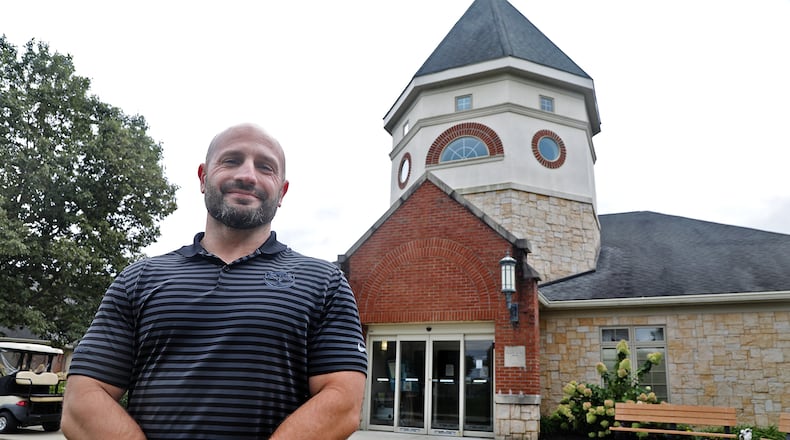“We have a system that needs to improve already, and we’re putting more people into it,” said Eric VanVlymen, executive director of the Alzheimer’s Association’s Miami Valley chapter.
Who is it impacting?
Roughly 6 million people nationwide, including more than 200,000 Ohioans, live with Alzheimer’s disease, which is the most common cause of dementia. The disease typically begins in the part of the brain that affects learning, according to the Alzheimer’s Association.
As Alzheimer’s advances through the brain, it leads to increasingly severe symptoms; this can include disorientation, mood and behavior changes, confusion, unfounded suspicions about people and difficulty speaking, swallowing and walking.
One in three people older than 65 dies with Alzheimer’s or another form of dementia. In 2019, more than 5,000 Ohioans died with the disease.
Age is the greatest risk factor for Alzheimer’s disease. More people are living past the age of 65, typically when Alzheimer’s disease presents itself in patients, due to advancements in health care and quality of life. As more people age, more people are impacted, VanVlymen said.
Ohio is the seventh most populous state nationwide, and its population is projected to grow by less than 1% over the next 30 years, according to a 2019 Miami University study. The population composition of the state is also shifting older; the study found that by 2025, more than 1 in 4 Ohioans will be aged 60 or older.
The Alzheimer’s Association estimates that as of 2020, roughly 220,000 Ohioans older than 65 live with Alzheimer’s disease. A predicted 250,000 will be living with the disease by 2025, a 13.6% increase.
By 2050, the population of Alzheimer’s patients in the state and nationwide is expected to double in size.
What are the problems
The expected influx of these patients statewide and to the area will impact not only patients themselves, but also health care systems and area families, VanVlymen said.
Although the number of assisted living and nursing home facilities is expanding in the area, health care systems are nationally in short supply of physicians who specialize in geriatrics, the branch of medicine dealing with the health and care of older people.
A significant shortage in the dementia healthcare workforce exists today, and Ohio would need to see a more than 200% increase in its number of geriatricians by 2050 to meet the projected demand, according to the Alzheimer’s Association.
More than 100,000 home health and personal care aids are employed in the state, but that total would need to increase, too, by 31% to meet the 2050 demand.
“For Springfield and Clark County, it can be kind of a double double whammy, as you have an aging population that also that percent of aging is higher and higher in that county,” VanVlymen said. “Which means you might have fewer caregivers who live there.”
The jump in the population of people most vulnerable for Alzheimer’s, too, will impact their caregivers. Two-thirds of people with dementia are living at home, and often, their caregivers are family members: most commonly, a child of the patient, VanVlymen said. Caregiving is a full-time commitment for many, and adults often have to juggle their jobs with raising children on top of caring for their parents.
“So many caregivers are trying to figure out how to balance their role,” he said. “And so they either have to step out of the workforce or they have to go part time, or they just feel divided.”
What is being done
United Seniors Services has been surveying Clark County households to gauge the needs of families, particularly what services family caregivers need. The survey was sent to 25,000 households in the county that have an occupant or occupants older than 65. Survey results are expected to roll in later this fall, executive director Maureen Fagans said.
The oncoming uptick in Alzheimer’s patients is part of the planning process for United Senior Services, Fagans said.
“We fully expect that family caregiving is going to be a part of the concern,” she said.
Caregivers in Clark County are currently expressing need for resources and support, said United Senior Services executive director Maureen Fagans.
“This is a growing issue,” she said. “The more we are armed with information, the better we will be able to respond to it.”
Roughly 20% of Clark County’s population is 65 and older, according to United Senior Services in Springfield. About 10% of that population is living with Alzheimer’s and dementia. Fagans said that her agency provides support services for the many family caregivers who help care for their loved ones, the majority of whom are living with dementia.
“We’re fighting very hard to provide them with the resources they need, some respite, some support,” she said.
United Senior Services offers a counselor that runs group support sessions and individual counseling. The agency also has transportation services and meal delivery options, and eligible families may also have access to home support services like assisting with the bathing of patients and light housekeeping.
Fagans said maintaining area caregivers’ wellness is “critical.”
“Many are on duty much more than a full-time job,” she said. “It’s important for them to have the rest they need so they can continue doing what they need to for their families.”
What care is available
About one-third of families seek long-term care outside the home for their loved ones with Alzheimer’s diseases, according to the Alzheimer’s Association.
The Ohio Masonic Home’s Springfield location, found at 2655 W. National Rd. in Springfield, has numerous residents living with Alzheimer’s and dementia at varying degrees of the disease. Its Pathways building is dedicated to Alzheimer’s and dementia patients who cannot live independently, said Tony Berardi, Springfield Masonic Community president.
The Pathways Center has 24-hour on-site nurses and dementia trained staff, among other services like social services and specialized programs.
Empathy is a crucial part of training for staff who work with Alzheimer’s and dementia patients and their families, Berardi said. The Masonic Home is working to train its staff about how Alzheimer’s impacts a patient through a virtual reality program called Embodied Labs. Participants wear the headset and are placed into a simulation where they are a character with one or more conditions. One simulation puts a person in the perspective of an Alzheimer’s patient, Beatrice. The simulation shows the characteristics of early, mid- and late-stage dementia.
Berardi said the Ohio Masonic Home is working with other service providers in the area – hospitals and organizations that primarily work with people who are older than 65 – to prepare for the influx of older patients.
“With the growth of everything that’s going to happen with the baby boomers that come in, we’re trying to make sure that we’re positioned to be able to provide the services that we offer to the best of our ability,” Berardi said.
No cure for Alzheimer’s
Although there’s no cure for Alzheimer’s, there are treatments that may change disease progression. Treatment options for Alzheimer’s patients are also expected to expand in the next few years, but patients need to be diagnosed with the disease to begin treatment. Health care providers do not regularly screen older patients for cognitive issues, per Alzheimer’s Association research.
“If the systems are not ready for when treatment comes, people in Springfield are going to be left out,” VanVlymen said. “We’re not ready for what we have.”
VanVlymen said the rarity of screening is a result of physicians being “overloaded” with patients. Running screens for cognitive issues increases the amount of time a physician will spend with a patient, and treatment for Alzheimer’s has been minimal for years.
The Alzheimer’s Association is working to encourage primary care sites to up their screening capabilities in order to diagnose people early and give them the option of beginning treatment and their loved ones more time to plan.
“What we’re looking for is to engage our communities to speak out and ensure that in the community that Alzheimer’s is understood, that it’s a priority and that we need to address it,” VanVlymen said.
The association is also boosting efforts to spread awareness about the disease. On Oct. 8, it will host the Walk to End Alzheimer’s in Dayton.
“We’re here to help communities brace what needs to happen to take care of our our seniors who are aging into this,” VanVlymen said.
The Alzheimer’s Association 24/7 hotline to offer support to individuals with Alzheimer’s and families caring for them can be reached at 800-272-3900.
By the Numbers
220,000: Number of Ohioans older than 65 living with Alzheimer’s disease as of 2020
12: The total, in millions, of Alzheimer’s patients expected by 2050 nationwide
25: Percent of Ohioans older than 65 living in the state
About the Author


